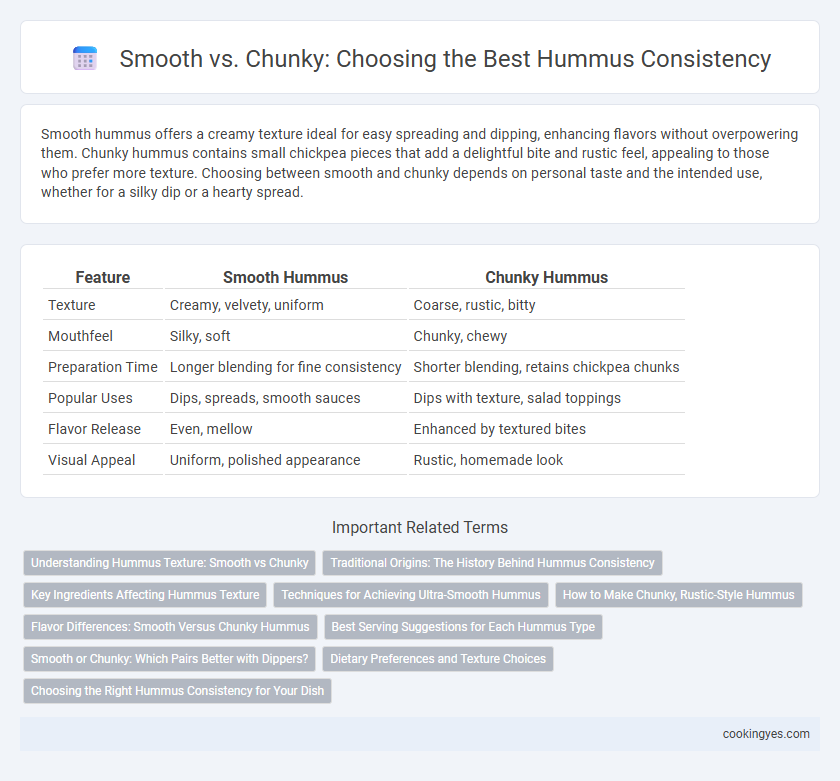Smooth hummus offers a creamy texture ideal for easy spreading and dipping, enhancing flavors without overpowering them. Chunky hummus contains small chickpea pieces that add a delightful bite and rustic feel, appealing to those who prefer more texture. Choosing between smooth and chunky depends on personal taste and the intended use, whether for a silky dip or a hearty spread.
Table of Comparison
| Feature | Smooth Hummus | Chunky Hummus |
|---|---|---|
| Texture | Creamy, velvety, uniform | Coarse, rustic, bitty |
| Mouthfeel | Silky, soft | Chunky, chewy |
| Preparation Time | Longer blending for fine consistency | Shorter blending, retains chickpea chunks |
| Popular Uses | Dips, spreads, smooth sauces | Dips with texture, salad toppings |
| Flavor Release | Even, mellow | Enhanced by textured bites |
| Visual Appeal | Uniform, polished appearance | Rustic, homemade look |
Understanding Hummus Texture: Smooth vs Chunky
Understanding hummus texture involves recognizing the difference between smooth and chunky consistencies, which primarily depends on the blending time and ingredient processing. Smooth hummus is creamy and uniform, achieved by thoroughly blending chickpeas, tahini, and olive oil until velvety, while chunky hummus retains small pieces of chickpeas for a heartier, more rustic feel. Texture preference influences the culinary use of hummus, with smooth varieties favored for dipping and chunky styles often utilized as robust spreads or toppings.
Traditional Origins: The History Behind Hummus Consistency
Traditional hummus origins in the Levant region emphasize a smooth, creamy consistency achieved by peeling chickpeas and blending them meticulously. Historically, the smooth texture reflects cultural preference and culinary techniques passed down through generations, highlighting the dish's refined nature. Chunky hummus variations, while popular today, represent modern adaptations that preserve some chickpea texture but diverge from the classic Levantine preparation.
Key Ingredients Affecting Hummus Texture
The texture of hummus, whether smooth or chunky, largely depends on the key ingredients and their preparation. Chickpeas cooked until very soft create a creamy base, while adding whole or slightly mashed chickpeas contributes to a chunkier consistency. The amount of tahini, olive oil, and ice water also influences smoothness, with higher tahini and careful blending resulting in a silkier hummus texture.
Techniques for Achieving Ultra-Smooth Hummus
Achieving ultra-smooth hummus relies on techniques like peeling chickpeas to remove skins, which significantly enhances creaminess. Using ice-cold water during blending emulsifies the mixture, creating a silky texture without thinning. High-powered blenders or food processors combined with extended blending times break down fibers thoroughly for a velvety consistency.
How to Make Chunky, Rustic-Style Hummus
To make chunky, rustic-style hummus, begin by partially mashing cooked chickpeas, leaving some whole for added texture. Incorporate coarsely chopped garlic and freshly ground spices like cumin and paprika, stirring gently to retain a slightly uneven consistency. Finish with a drizzle of high-quality extra-virgin olive oil and a sprinkle of toasted pine nuts to enhance the rich, hearty flavor profile.
Flavor Differences: Smooth Versus Chunky Hummus
Smooth hummus offers a creamy texture that enhances the rich, nutty flavor of blended chickpeas and tahini, providing a consistent and velvety taste experience. Chunky hummus introduces a more robust, rustic bite with visible chickpea pieces, delivering a varied texture that emphasizes the natural, earthy flavors of its ingredients. The choice between smooth and chunky affects not only mouthfeel but also how the hummus flavors are perceived and enjoyed.
Best Serving Suggestions for Each Hummus Type
Smooth hummus pairs exceptionally well with crisp vegetable sticks and warm pita bread, highlighting its creamy texture for easy dipping. Chunky hummus complements grilled meats and roasted vegetables, adding a satisfying, hearty bite that enhances flavors and mouthfeel. Serving smooth hummus as a spread on sandwiches contrasts with chunky hummus as a standalone appetizer, maximizing the appeal of each consistency.
Smooth or Chunky: Which Pairs Better with Dippers?
Smooth hummus offers a creamy texture that effortlessly coats dippers like pita bread, vegetables, and crackers, making each bite rich and consistent. Chunky hummus, with its slightly coarse texture and visible chickpea pieces, provides a satisfying bite and adds a textural contrast that enhances the dipping experience. Choosing between smooth or chunky largely depends on personal preference and the type of dippers used, as smooth hummus suits softer options while chunky complements crunchier snacks.
Dietary Preferences and Texture Choices
Smooth hummus offers a creamy texture ideal for those seeking a velvety mouthfeel and easy digestibility, often preferred in gluten-free and low-fiber diets. Chunky hummus provides a coarser texture with visible chickpea pieces, appealing to individuals desiring added fiber and a more rustic, hearty experience. Both variations accommodate diverse dietary preferences, balancing texture and nutritional benefits to suit personal taste and health goals.
Choosing the Right Hummus Consistency for Your Dish
Smooth hummus offers a creamy texture that blends seamlessly with pita or fresh vegetables, ideal for dipping and spreading. Chunky hummus provides a hearty bite with visible pieces of chickpeas, enhancing salads and Mediterranean plates with added texture. Selecting the right consistency depends on the dish's purpose, with smooth best for dips and spreads and chunky preferred for toppings or recipes requiring a robust mouthfeel.
Smooth vs Chunky for hummus consistency Infographic

 cookingyes.com
cookingyes.com